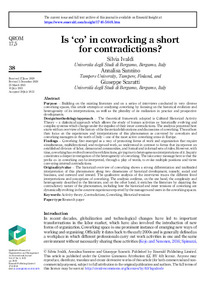Is ‘co’ in coworking a short for contradictions?
Ivaldi, Silvia; Sannino, Annalisa; Scaratti, Giuseppe (2021)
Ivaldi, Silvia
Sannino, Annalisa
Scaratti, Giuseppe
2021
Julkaisun pysyvä osoite on
https://urn.fi/URN:NBN:fi:tuni-202201111253
https://urn.fi/URN:NBN:fi:tuni-202201111253
Kuvaus
Peer reviewed
Tiivistelmä
Purpose: Building on the existing literature and on a series of interviews conducted in very diverse coworking spaces, this article attempts at analyzing coworking by focusing on the historical evolution and heterogeneity of its interpretations, as well as the plurality of its realization in practice and prospective developments. Design/methodology/approach: The theoretical framework adopted is Cultural Historical Activity Theory – a dialectical approach which allows the study of human activities as historically evolving and complex systems which change under the impulse of their inner contradictions. The analysis presented here starts with an overview of the history of the theoretical elaborations and discussions of coworking. The authors then focus on the experiences and interpretations of this phenomenon as conveyed by coworkers and coworking managers in the north of Italy – one of the most active coworking areas in Europe. Findings: Coworking first emerged as a way of promoting forms of work and organization that require simultaneous, multidirectional, and reciprocal work, as understood in contrast to forms that incorporate an established division of labor, demarcated communities, and formal and informal sets of rules. However, with time, coworking has evolved toward novel directions, giving rise to heterogeneous interpretations of it. Inquiry constitutes a deeper investigation of the heterogeneity of coworking. The take-away message here is that the prefix co- in coworking can be interpreted, through a play of words, to evoke multiple positions and views conveying internal contradictions. Originality/value: The historical overview of coworking shows a strong differentiation and multisided interpretation of this phenomenon along two dimensions of historical development, namely, social and business, and outward and inward. The qualitative analysis of the interviews traces the different lived interpretations and conceptions of coworking. The analysis confirms, on the one hand, the complexity and heterogeneity described in the literature, and on the other hand, it enriches the literature by depicting the contradictory nature of the phenomenon, including how the historical and inner tensions of coworking are dynamically evolving in the concrete experiences reported by the managers and users in the coworking spaces.
Kokoelmat
- TUNICRIS-julkaisut [16983]
